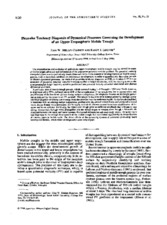| dc.creator | Nielsen-Gammon, John | |
| dc.creator | Lefevre, Randy | |
| dc.date.accessioned | 2016-10-28T18:35:07Z | |
| dc.date.available | 2016-10-28T18:35:07Z | |
| dc.date.issued | 1996-11-01 | |
| dc.identifier.citation | Nielsen-Gammon, J. W., and R. J. Lefevre, 1996: Piecewise tendency diagnosis of dynamical processes governing the development of an upper-tropospheric mobile trough. J. Atmos. Sci., 53, 3120-3142. | en |
| dc.identifier.uri | https://hdl.handle.net/1969.1/158217 | |
| dc.description | © Copyright 1996 American Meteorological Society (AMS). Permission to use figures, tables, and brief excerpts from this work in scientific and educational works is hereby granted provided that the source is acknowledged. Any use of material in this work that is determined to be “fair use” under Section 107 of the U.S. Copyright Act September 2010 Page 2 or that satisfies the conditions specified in Section 108 of the U.S. Copyright Act (17 USC §108, as revised by P.L. 94-553) does not require the AMS’s permission. Republication, systematic reproduction, posting in electronic form, such as on a web site or in a searchable database, or other uses of this material, except as exempted by the above statement, requires written permission or a license from the AMS. Additional details are provided in the AMS Copyright Policy, available on the AMS Web site located at (https://www.ametsoc.org/) or from the AMS at 617-227-2425 or copyrights@ametsoc.org. | en |
| dc.description.abstract | The intensification and evolution of midlatitude upper-tropospheric mobile troughs may be viewed in terms of the isentropic advection and deformation of the tropopause potential vorticity gradient. The potential vorticity viewpoint allows one to qualitatively assess observed events in the context of existing theories of mobile trough genesis, such as baroclinic instability or downstream development. In order to quantitatively determine the role of distinct dynamical process, the method of piecewise tendency diagnosis, or PTD, is developed. PTD is an extension of piecewise potential vorticity inversion applied to height tendencies, with the forcing terms in the quasigeostrophic height tendency equation partitioned into potential vorticity advection associated with distinct dynamical processes.
A particular case of mobile trough genesis, which occurred during 1–4 December 1980 over North America is diagnosed using PTD. Although about 20% of the intensification of the trough was due to superposition and amplification of the low-level cyclone during surface cyclogenesis, the diagnosis focuses on the height perturbation induced by the upper-level PV anomaly. The trough is found to have formed primarily through down-stream propagation of Rossby wave energy from disturbances over the, northwest Pacific. As the trough amplified, it interacted with an existing surface temperature gradient over the central United States and produced a front wave. As the frontal wave intensified, the favorable vertical tilt allowed mutual baroclinic amplification of the upper and lower systems. Eventually, the upper-level trough grew to sufficient amplitude that it began to lose energy downstream through wave propagation and the trough began to weaken even though a favorable tilt remained between the upper and lower systems. Horizontal deformation and small-scale vortex interaction were less important to the overall development of the mobile trough, but contributed significantly to intensification at various times in its lift cycle. The direct effects of the remaining dynamical processes excluding latent heating and friction, which were not diagnosed) were insignificant. | en |
| dc.description.sponsorship | National Science Foundation | en |
| dc.language.iso | en_US | |
| dc.publisher | American Meteorological Society | |
| dc.subject | potential vorticity | en |
| dc.subject | synoptic dynamics | en |
| dc.title | Piecewise Tendency Diagnosis of Dynamical Processes Governing the Development of an Upper-Tropospheric Mobile Trough | en |
| dc.type | Article | en |
| local.department | Atmospheric Sciences | en |
| dc.identifier.doi | 10.1175/1520-0469(1996)053<3120:PTDODP>2.0.CO;2 | |


